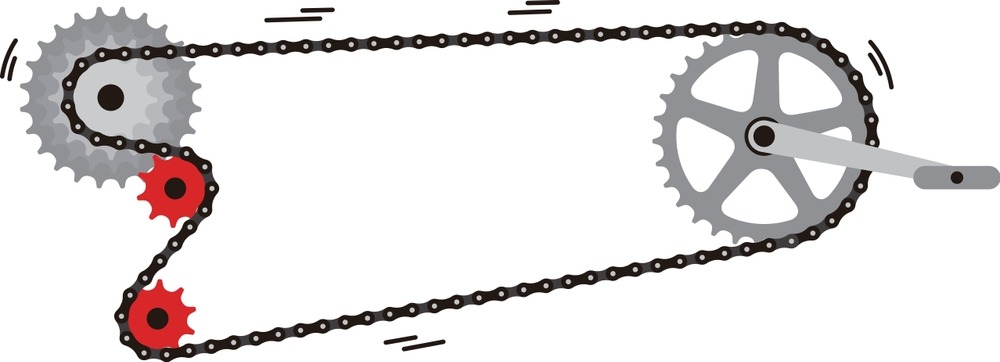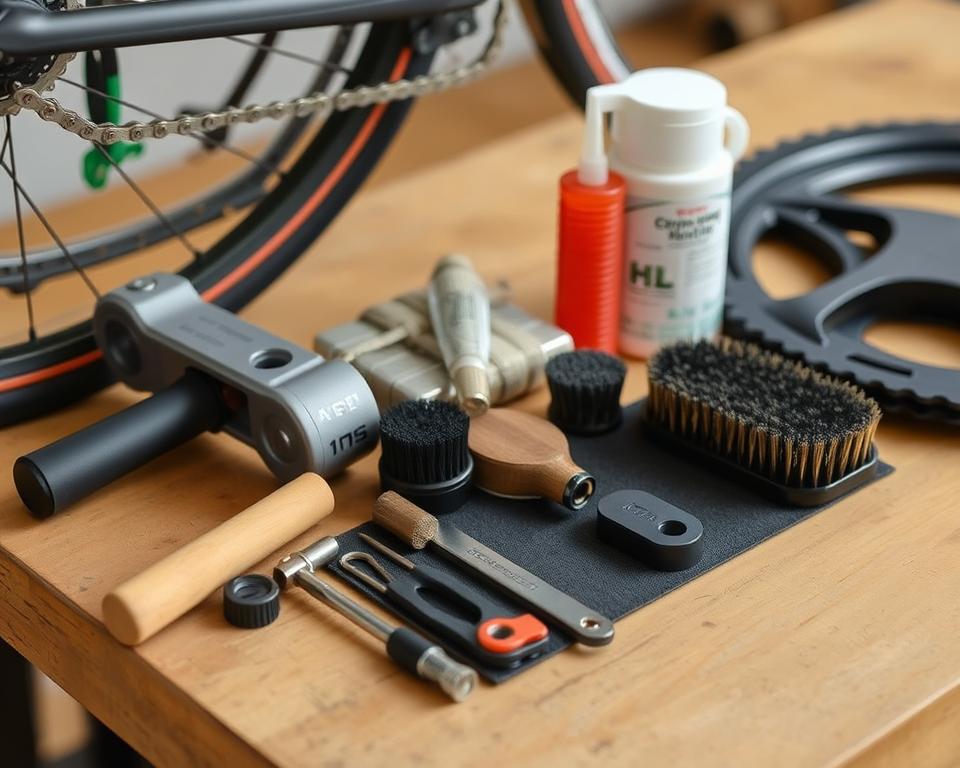Are you a road bike enthusiast who wants to keep your ride in top shape? Look no further! This guide will cover DIY road bike chain lubrication. We’ll look at the key parts, maintenance tips, and the best products for a smooth chain.
Whether you’re an experienced cyclist or just starting, this article will help. You’ll learn how to handle chain maintenance like a pro.
Key Takeaways
- Understand the basic components of a bike chain and how they work together
- Learn the importance of regular chain maintenance for optimal performance and longevity
- Discover the differences between dry and wet chain lubes, and how to choose the right one for your riding conditions
- Gain insights into creating your own DIY chain lube using common household ingredients
- Explore the signs of chain wear and when to replace it for a smooth and efficient ride
Understanding Chain Components
Your bike’s chain is key to your ride, linking your pedals to the rear wheel. It’s made of several parts that work together. Knowing about the outer links, inner links, rollers, and pins helps you care for it better.

Outer Links
The outer links are the big, visible parts of the chain. They’re made of strong steel and have holes for movement. Keeping them well-lubricated reduces friction and extends your chain’s life.
Inner Links
The inner links are smaller and fit between the outer links. They have special parts that let the chain move with the wheel. It’s important to keep them lubricated for smooth riding.
Rollers
The rollers are the round parts that link the inner and outer links. They’re where the chain meets the bike’s gears. Lubricating them well is key to reducing friction and wear.
Pins
The pins hold the chain’s links together. They’re crucial for the chain’s strength and must be in good shape. Worn pins might mean you need a new chain.
Knowing your bike’s chain parts is the first step to keeping it in top shape. By keeping them well-lubricated, you’ll get more life and performance from your chain.
Importance of Regular Chain Maintenance
Keeping your bike’s chain well-maintained is key for its performance and life. As the factory grease fades, your chain needs benefits of regular chain lubrication to fight friction, wear, and corrosion. Cleaning and lubricating your chain regularly makes your ride smooth and extends the life of your chain and other parts.
Ignoring chain care can cause it to wear out faster. This means you might need to replace expensive parts sooner. Chains should be replaced when they stretch by just 0.75%. Some riders clean their chain after every ride, while others wait until it looks dirty.

“A clean, well-lubricated chain is essential for the longevity of your drivetrain components and a smooth, efficient ride.”
Chains come pre-greased from the factory, but that grease doesn’t last. Before adding new lube, clean your chain to prevent wear from dirt. You can apply lube to the cassette, pulley wheels, or the chain’s underside between the chainring and pulley wheels.
Regular importance of bike chain maintenance and benefits of regular chain lubrication are vital for bike care. They save you time and money over time. A well-maintained chain ensures a responsive, efficient, and reliable ride for years.
Cleaning the Chain
Before you add new lubricant to your road bike’s chain, make sure it’s clean. Use a bike-specific degreaser, brushes, and rags to clean the chain, cassette, and derailleur. This step is key to keeping your bike running well.
Tools and Materials Needed
- Bike-specific degreaser
- Stiff-bristled brush
- Clean rags or paper towels
- Chain cleaning tool (optional)
- Reusable masterlink (optional)

Step-by-Step Process
- Apply degreaser to the chain, cassette, and derailleur. Let it soak for a few minutes to loosen grime.
- Scrub the chain, cassette, and derailleur with a stiff-bristled brush. Make sure to get into all the tight spots.
- If you have a chain cleaning tool, run the chain through it. This will clean both sides of the links.
- Wipe the chain, cassette, and derailleur with clean rags or paper towels. This removes any leftover degreaser and dirt.
- Make sure the chain is dry before you apply new lubricant.
Cleaning your bike’s chain properly helps save power and makes your drivetrain last longer. The right tools and a good cleaning routine are vital for a smooth ride.
“An average dirty road chain can decrease efficiency by about 3 to 5 watts, which represents about 1 to 2 percent of power loss for a 250-watt rider output.”

Road Bike Chain Lubrication
Keeping your road bike’s chain in top shape is key for its performance and life. After cleaning the chain, you need to apply the right lubricant. There are “dry” and “wet” lubes, each suited for different riding conditions.
Types of Lubes: Dry vs Wet
Dry lubes are great for dry, dusty areas because they attract less dirt. They often have Teflon or synthetic compounds to keep contaminants away. Finish Line Dry Lube and Smoove Lube are good choices.
Wet lubes, however, offer better protection in rainy weather. They use oils to reach the chain’s inner parts, preventing rust and wear. Muc-Off Wet Lube and Green Oil Wet Lube are top picks for wet conditions.
Application Techniques
Applying lube correctly is vital for your bike’s performance and protection. When using types of bike chain lube, squirt it on the chain rollers while pedaling backwards. This helps the lube get into the chain’s inner links and rollers, how to apply bike chain lube.
After a few minutes, use a clean rag to remove any extra lube. This leaves a thin, even layer on the chain.
Whether you pick a dry vs wet bike chain lube, regular lubrication is crucial. It keeps your bike’s drive train smooth, efficient, and quiet. Try out different lubes to see what works best for you.

“Proper lubrication is the key to a long-lasting and reliable bike chain. Don’t skimp on the quality of your lube – it can make a significant difference in the performance and lifespan of your drivetrain.”
Ingredients for DIY Chain Lube
Creating your own chain lube is easy with simple ingredients. You’ll need STP oil treatment with zinc oxide, light machine oil, and PTFE (Teflon) powder. These help make a great lubricant.
STP with Zinc Oxide
STP oil treatment, with zinc oxide, is about 55% of the mix. It protects the chain links from wear and corrosion.
Light Machine Oil
Light machine oil makes up 25% of the mix. It thins the lube for better flow and penetration into the chain.
PTFE Powder
PTFE powder settles at the bottom and is 15-20% of the lube. It boosts the lubricating effect, reducing friction and wear.
This DIY bike chain lube can be adjusted for different weather. Using it right keeps your bike chain smooth.

“Considerations indicate that road commuting is the best use for this specific chain lube, while racers may require a more temporary wax-based lube, such as Molten speed wax, typically made with PTFE.”
Chain Wear and Replacement
As a cyclist, keeping your bike in top shape is key. One important part to watch is the chain. Even with regular care, chains will wear out and need a new one. But how do you know when it’s time for a change?
The signs of a worn bike chain include bad shifting and faster wear on the chainring and cassette. You’ll also notice the chain’s pins getting farther apart. A tool like the Park Tool CC-3.2 Chain Wear Indicator, can help you see when it’s time for a new chain.
Swapping out your chain before it’s too worn can also help your other parts last longer. This includes the cassette and chainring. The average bike chain replacement interval is about 1,500 miles. But this can change based on how you ride and the conditions you face.

“Chains usually need replacement at 0.75% stretch; tools like the Park Tool CC-3.2 Chain Wear Indicator Tool are used to check for chain wear.”
When deciding when to replace bike chain, it’s safer to be early. Replacing your chain before it’s too worn can save money by making your other parts last longer. So, make sure to check your chain often and replace it when needed.
Conclusion
Proper road bike chain lubrication is key for a smooth ride. It keeps your bike’s drivetrain running well for a long time. Knowing how to clean and lubricate your chain is important.
Choosing the right lubricant is crucial. You can use store-bought lube or make your own. The goal is to protect the chain’s rollers.
Keeping your bike’s chain in good shape is easy but important. The right lubricant should protect against rust and water. It should also stick well to the chain.
Things like cleanliness and lubrication affect your chain’s life. A clean and well-lubricated chain lasts longer. This means your bike will run smoothly for years.
Stay up to date with the latest in chain care. This way, your bike’s drivetrain will always perform at its best.
FAQs
What are the key components of a bike chain?
A bike chain has outer and inner links, rollers, and pins. These parts work together. They let the chain move as you pedal.
Why is it important to regularly clean and lubricate a bike chain?
Cleaning and lubricating a bike chain is key for its performance and life. The factory grease wears off, so the chain needs new lubrication. This reduces friction and wear, keeping the chain and other parts running smoothly.
What are the steps for properly cleaning a bike chain?
To clean a bike chain, start with a bike-specific degreaser. Use brushes and rags to scrub all parts. Dry the chain well before applying new lubricant. Having the right tools makes this easy.
What are the different types of bike chain lubes and how do they differ?
Bike chain lubes come in “dry” and “wet” types. Dry lubes keep dirt away, while wet lubes protect longer, especially in rain.
How can I make my own DIY chain lube?
Mix STP oil treatment, zinc oxide, light machine oil, and PTFE powder for a DIY lube. Adjust the ingredients for different weather. This homemade lube can be customized.
How do I know when it’s time to replace my bike chain?
As a chain wears, the gap between pins grows. This causes poor shifting and faster wear on other parts. Use a tool or measure the stretch to know when to replace it.






